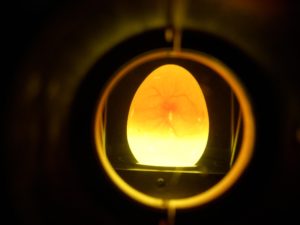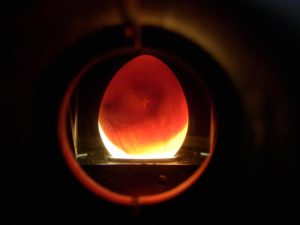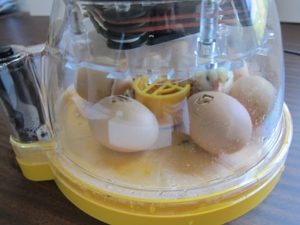How to Hatch Eggs
by Guest blogger: Pascale Pearce
of Brinsea
Listen to her podcast HERE
You like the idea of incubating chicken eggs to raise your own flock of backyard chickens but have concerns about the cost and difficulty factor. Hatching chicken eggs is fun and easy if you follow these simple guidelines.
Choose a good incubator
Incubators have come a long way and now you can purchase a good quality incubator to hatch up to a dozen eggs for $100 but be wary of cheap imports; they may not meet electrical safety standards.
An accurate temperature control is key so look for an incubator with reliable electronic temperature control. Look for incubators made of impervious materials and with simple turning mechanisms which can be cleaned easily and will not be a breeding ground for bacteria.
Turning can be done manually but bearing in mind eggs need to be turned at least three times a day and preferably every hour you may want to consider automatic turning. Some fully digital models like the Brinsea Mini and Maxi Advance even count down to hatch day and automatically stop the turning two days prior.
Get quality fertile eggs
Apart from a good incubator you will need fertile eggs. Here’s an important egg fact: grocery store eggs will not hatch! If you have a flock of healthy hens and a rooster you’re all set. If you don’t have a rooster it’s always best to source your fertile eggs locally. They will be fresher and their chances of hatching won’t have been compromised by jostling and extreme temperatures during shipping.
Eggs can be stored up to a week provided they are kept cool (around 55°F with 75% humidity) stored pointed end down and turned once a day. Misshaped, cracked or dirty eggs should not be set in an incubator.
Set up your incubator ahead of time
You should read the user manual and run the incubator several days before setting eggs to ensure everything is working properly.
Allow eggs to warm up to room temperature before setting them. Place them in the incubator on their side or pointed end down and do not adjust the temperature for 24 hours. Don’t forget to check the water reservoirs regularly following the manufacturer’s recommendations to achieve the correct humidity.
Now let nature take its course. An incubator will not hatch faster – chicks still need 21 days!
Now the fun part – candling!
By shining a bright light through the shell candling allows you to monitor fertility and embryo development. Originally candles were used – hence candling.
Modern candlers are usually LEDs because they are very bright, very efficient and do not emit heat that might damage embryos. Some like the Brinsea OvaScope can be used anywhere (not just darkened rooms) and can be hooked up to a webcam.
Eggs may be candled after 5 days of incubation and every few days thereafter. For best results you should candle eggs in a darkened room holding the candler right against the shell at the larger end.
Initially you will be able to see a small embryo and a web of blood vessels radiating from it.

Egg candled at Day 5 in a Brinsea OvaScope
As the chick grows it will be hard to make out detail but you should still be able to see movement.

Egg candled at Day 10 in a Brinsea OvaScope
Conversely, infertile eggs will remain clear and eggs which have died will show a dark ring. By being able to identify and remove non-viable eggs you can avoid contaminating your hatch with germs.
It will take a little practice to become confident. Do not discard any eggs if you are unsure. Have another look a few days later before deciding.
The magical hatching…
Two days before the eggs are due to hatch you should stop turning and make sure the water reservoirs are well topped up. Humidity needs to be high during hatching so do not open the incubator.
Birth takes time! 24 hours or more from the first bump on the shell until the chicks emerges all wet and exhausted.
So be patient, don’t be tempted to help and don’t transfer the chicks under a brooder until they are fully fluffed up or they could chill.
Your patience will be rewarded with little bundles of fuzzy cuteness nobody can resist.
Beware hatching is addictive! Happy Hatching!
For more information on candling and incubation you can download a free Incubation Handbook from www.brinsea.com.
UrbanFarm.org/hatchingeggs
About this author:
 A native of France, Pascale is a graduate of Bordeaux Business School where she earned an MBA specializing in International Trade. In 1994 in the UK, she started as Brinsea Export Manager and joined Brinsea USA in 1998 shortly after its creation where she was in charge of business development.
A native of France, Pascale is a graduate of Bordeaux Business School where she earned an MBA specializing in International Trade. In 1994 in the UK, she started as Brinsea Export Manager and joined Brinsea USA in 1998 shortly after its creation where she was in charge of business development.
Brinsea® is a family run business offering bird breeding and veterinarian products. Established in 1976 by an engineer with an interest in breeding birds it quickly became a passion, which coupled with his background and enthusiasm has produced the most innovative egg incubators and brooders available.
With 25 years’ experience in the bird breeding and animal intensive care, Pascale enjoys sharing her knowledge of incubation with backyard breeders to make hatching an enjoyable experience they will want to repeat.
Brinsea Products are the world leading incubation specialists. They have been manufacturing affordable, quality incubators since 1976 and are the choice of backyard breeders through research establishments. Visit www.brinsea.com or call 1-888-667-7009 for more information on their full line of incubators, brooders and breeding equipment all with a 3-year warranty.




I enjoyed this article on egg incubation. I add that an incubator needs to be cleaned prior to each new incubation. The Rcom egg incubators makes incubating eggs fun and profitable. They have automatic Temperature, humidity and eggs turning which saves time. The Rcom egg incubators found at https://www.rcomco.com offers the Pro series which has programmed for various eggs varieties and customize them as the user wish. Additionally, the Pro series remembers automatically when to stop turning for the last hatching days which is so convenient if you are in a classroom or away from home or just forgot to stop the turning of the eggs automatically. Cleaning the machine is super easy. They can be reset to factory default and calibrating the Temperature and humidity for excellent quality control especially before each hatching using an external meter that measures the temperature and humidity. There is joy to observing egg hatching
Untrue that grocery store purchased eggs won’t hatch as recent experiments have shown that many will.
This article appears to be an advertisement for Brinsea. Granted the Brinsea incubators are a good product but there are other incubators like the Janoel24 and Janoel24S which are made in China which do a great job too at half the price.
Mark,
Thank you for your comment and for sharing other options. Our goal is to offer informative podcasts that serve to enlighten and empower, and this particular podcast was about hatching eggs using incubators and give our listeners a resource for more information. We did not get any payment for this or any of our podcasts (we do sometimes get a sample book or item to review, but not in this case). If you would like to submit a review of incubators for consideration as a blog post, send me an email at janis@urbanfarm.org. Thanks again!